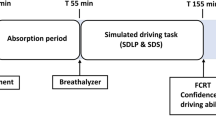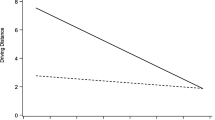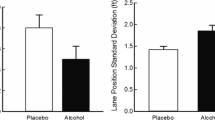Abstract
Rationale
Research indicates that alcohol intoxication and increased demands on drivers’ attention from distractions (e.g., passengers and cell phones) contribute to poor driving performance and increased rates of traffic accidents and fatalities.
Objectives
The present study examined the separate and combined effects of alcohol and distraction on simulated driving performance at blood alcohol concentrations (BrACs) below the legal driving limit in the USA (i.e., 0.08 %).
Methods
Fifty healthy adult drivers (36 men and 14 women) were tested in a driving simulator following a 0.65-g/kg dose of alcohol and a placebo. Drivers completed two drive tests: a distracted drive, which included a two-choice detection task, and an undistracted control drive. Multiple indicators of driving performance, such as drive speed, within-lane deviation, steering rate, and lane exceedances were measured.
Results
Alcohol and distraction each impaired measures of driving performance. Moreover, the magnitude of alcohol impairment was increased by at least twofold when tested under the distracting versus the undistracted condition.
Conclusions
The findings highlight the need for a clearer understanding of how common distractions impact intoxicated drivers, especially at BrACs that are currently legal for driving in the USA.

Similar content being viewed by others
References
Borkenstein RF, Crowther RF, Shumate RP (1974) The role of the drinking driver in traffic accidents (the Grand Rapids study). Blutalkohol 11(Suppl 1):1–131
Fell JC, Voas RB (2014) The effectiveness of a 0.05 blood alcohol concentration (BAC) limit for driving in the United States. Addiction 109:869–874
Fillmore MT (2001) Cognitive preoccupation with alcohol and binge drinking in college students: alcohol-induced priming of the motivation to drink. Psychol Addict Behav 15:325–332
Fillmore MT (2007) Acute alcohol-induced impairment of cognitive functions: past and present findings. Int J Dis Hum Dev 6:115–126
Fillmore MT, Blackburn JS, Harrison EL (2008) Acute disinhibiting effects of alcohol as a factor in risky driving behavior. Drug Alcohol Depend 95:97–106
Fisk AD, Schneider W (1984) Task versus component consistency in automatic process development: consistent attending versus consistent responding. Bull Psychon Soc 22:330–332
Harrison EL, Fillmore MT (2005) Are bad drivers more impaired by alcohol?: sober driving precision predicts impairment from alcohol in a simulated driving task. Accid Anal Prev 7:882–889
Harrison EL, Fillmore MT (2011) Alcohol and distraction interact to impair driving performance. Drug Alcohol Depend 117:31–37
Harrison EL, Marczinski CA, Fillmore MT (2007) Driver training conditions affect sensitivity to the impairing effects of alcohol on a simulated driving test to the impairing effects of alcohol on a simulated driving test. Exp Clin Psychopharmacol 15:588–598
Hurst PM (1973) Epidemiological aspects of alcohol in driver crashes and citations. J Saf Res 5:130–148
Marczinski CA, Harrison EL, Fillmore MT (2008) Effects of alcohol on simulated driving and perceived driving impairment in binge drinkers. Alcohol Clin Exp Res 32:1329–1337
Martin TL, Solbeck PA, Mayers DJ, Langille RM, Buczek Y, Pelletier MR (2013) A review of alcohol‐impaired driving: the role of blood alcohol concentration and complexity of the driving task. J Forensic Sci 58:1238–1250
Mercer SL, Sleet DA, Elder RW, Cole KH, Shults RA, Nichols JL (2010) Translating evidence into policy: lessons learned from the case of lowering the legal blood alcohol limit for drivers. Ann Epidemiol 20:412–420
Michon JA (1985) A critical view of driver behavior models: what do we know, what should we do? In: Evans L, Schwing RC (eds) Hum Beh Traffic Saf. Plenum Press, New York, pp 485–520
Moskowitz H, Burns MM, Williams AF (1985) Skills performance at low blood alcohol levels. J Stud Alcohol 46:482–485
Mulvihill LE, Skilling TA, Vogel-Sprott M (1997) Alcohol and the ability to inhibit behavior in men and women. J Stud Alcohol 58:600–605
National Highway Traffic Safety Administration (2013) Traffic safety facts 2012 data: alcohol-impaired driving. DOT HS 811 870. U.S. Department of Transportation, National Highway Traffic Safety Administration, Washington
National Transportation Safety Board, Bureau of Safety Programs, & United States of America. (2013). Reaching zero: actions to eliminate alcohol-impaired driving
Ogden EJD, Moskowitz H (2004) Effects of alcohol and other drugs on driver performance. Traffic Inj Prev 5:185–198
Papantoniou P, Papadimitriou E, Yannis G (2013a) Assessment of driving simulator studies on driver distraction. Adv Trans Stud 35:129
Papantoniou P, Papadimitriou E, Yannis G (2013) Assessment of driving simulator studies on driver distraction. In Road safety and simulation international conference (pp. 22–25)
Patten CJ, Kircher A, Östlund J, Nilsson L (2004) Using mobile telephones: cognitive workload and attention resource allocation. Accid Anal Prev 36:341–350
Rakauskas ME, Ward NJ, Boer ER, Bernat EM, Cadwallader M, Patrick CJ (2008) Combined effects of alcohol and distraction on driving performance. Accid Anal Prev 40:1742–1749
Salvucci DD (2006) Modeling driver behavior in a cognitive architecture. Hum Factors 48:362–380
Shiffrin RW, Dumais ST (1981) The development of automatism. In: Anderson JR (ed) Cognitive skills and their acquisition. Lawrence Erlbaum Associates, Hillsdale, pp 111–140
Shinar D, Tractinsky N, Compton R (2005) Effects of practice, age, and task demands, on interference from a phone task while driving. Accid Anal Prev 37:315–326
Sobell LC, Sobell MB (1992) Timeline followback: a technique for assessing self-reported alcohol consumption. In: Litten RZ, Allen J (eds) Measuring alcohol consumption: psychosocial and biological methods. Humana Press, New Jersey, pp 41–72
Verster JC, Wester AE, Goorden M, Van Wieringen JP, Olivier B, Volkerts ER (2009) Novice drivers’ performance after different alcohol dosages and placebo in the divided-attention steering simulator (DASS). Psychopharmacology 204:127–133
Zador PL (1991) Alcohol-related relative risk of fatal driver injuries in relation to driver age and sex. J Stud Alcohol Drugs 52:302
Zador PL, Krawchuk SA, Voas RB (2000) Alcohol-related relative risk of driver fatalities and driver involvement in fatal crashes in relation to driver age and gender: an update using 1996 data. J Stud Alcohol Drugs 61:387
Acknowledgments
This research was supported by the National Institute on Alcohol Abuse and Alcoholism Grant R01 AA021722 and National Institute on Drug Abuse Grant T32 DA035200. The content is solely the responsibility of the authors and does not necessarily represent the official views of the National Institutes of Health. Both authors designed the study, wrote the protocol, collected the data, and undertook the statistical analyses. All authors contributed to and have approved the final manuscript. All authors declare that they have no conflicts of interest.
Author information
Authors and Affiliations
Corresponding author
Rights and permissions
About this article
Cite this article
Van Dyke, N.A., Fillmore, M.T. Distraction produces over-additive increases in the degree to which alcohol impairs driving performance. Psychopharmacology 232, 4277–4284 (2015). https://doi.org/10.1007/s00213-015-4055-2
Received:
Accepted:
Published:
Issue Date:
DOI: https://doi.org/10.1007/s00213-015-4055-2




